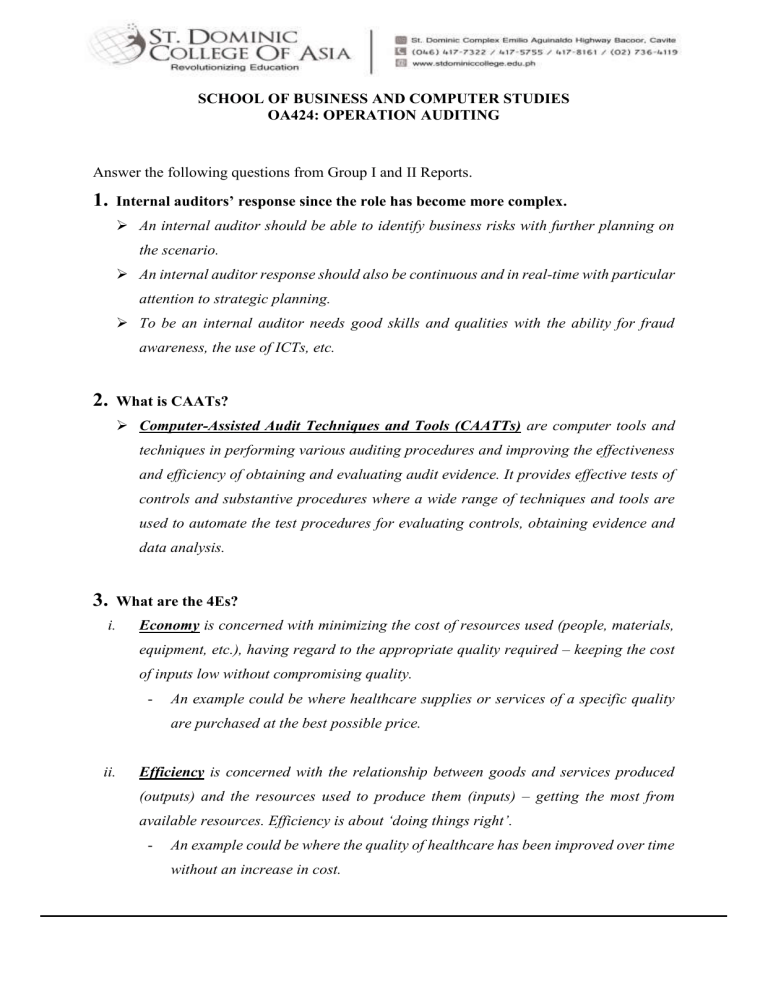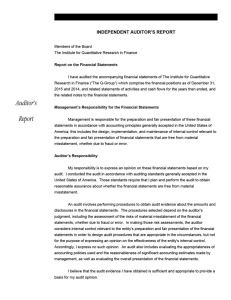
SCHOOL OF BUSINESS AND COMPUTER STUDIES OA424: OPERATION AUDITING Answer the following questions from Group I and II Reports. 1. Internal auditors’ response since the role has become more complex. An internal auditor should be able to identify business risks with further planning on the scenario. An internal auditor response should also be continuous and in real-time with particular attention to strategic planning. To be an internal auditor needs good skills and qualities with the ability for fraud awareness, the use of ICTs, etc. 2. What is CAATs? Computer-Assisted Audit Techniques and Tools (CAATTs) are computer tools and techniques in performing various auditing procedures and improving the effectiveness and efficiency of obtaining and evaluating audit evidence. It provides effective tests of controls and substantive procedures where a wide range of techniques and tools are used to automate the test procedures for evaluating controls, obtaining evidence and data analysis. 3. i. What are the 4Es? Economy is concerned with minimizing the cost of resources used (people, materials, equipment, etc.), having regard to the appropriate quality required – keeping the cost of inputs low without compromising quality. - An example could be where healthcare supplies or services of a specific quality are purchased at the best possible price. ii. Efficiency is concerned with the relationship between goods and services produced (outputs) and the resources used to produce them (inputs) – getting the most from available resources. Efficiency is about ‘doing things right’. - An example could be where the quality of healthcare has been improved over time without an increase in cost. SCHOOL OF BUSINESS AND COMPUTER STUDIES OA424: OPERATION AUDITING iii. Effectiveness is concerned with achieving predetermined objectives (specifically planned achievements) and having the actual impact (output achieved) compared with the intended impact (objective) – achieving the predetermined objective. Effectiveness is about ‘doing the right things. - An example could be where disease rates have fallen because of healthcare provided. iv. Ethics is the standard of moral behavior and conduct expected of organizations and their employees. This has a direct effect on the operation of controls and therefore on the achievement of the other 3Es. 4. Operational objectives are attainable, action-oriented, short-term goals organizations set and accomplish as a means of partially achieving larger, long-term objectives. 5. Differentiate FINANCIAL, COMPLIANCE, AND OPERATIONAL AUDITS. Financial audits are responsible for how financial statements are prepared and presented, whether they are done fairly and in accordance with the established accounting criteria. Operational audits are the assessment of the efficiency and effectiveness of the operating policies and the procedures. Compliance audit is what determines if the company is compliant with the policies and regulations that are implemented with either contractual agreement; they are in, the company management, the government, and other authority of higher rankings. 6. A process can be defined as a series of purposeful steps or actions that, when completed, produce the desired result. Thus, one of the first steps in an operational audit is to identify the processes being reviewed. SCHOOL OF BUSINESS AND COMPUTER STUDIES OA424: OPERATION AUDITING 7. A pre-audit meeting lays the foundation for the operational audit process, state the process to do. a. Collect background information about the business helps identify any areas of concern or industry-specific challenges that need to be addressed. b. Conduct interviews with managers in control of potentially risky areas. c. Document objectives and activities with risk highlighted and sent back to the managers for confirmation. d. Tests are conducted, with results meticulously documented, to show which new processes or goals can improve the Organization's efficiency using operational trouble spots. e. Auditor writes up a comprehensive audit report. Follow-up visits with management can help to fine-tune any ongoing issues with new systems or controls. 8. Part of the objective should also be to maintain quality in the auditing process. Identify the main standard areas that govern audits. Part of the objective should also be to maintain quality in the auditing process. The graphic below covers the main standard areas that govern audits: 1. Integrity: Withstand pressures that may be exerted and take care to comply with any legal requirements. 2. Fair Presentation: Present all results fairly and report significant concerns. 3. Due Professional Care: Use diligence, due care, and reasoned judgments in every situation. 4. Confidentiality: Keep information secure and protect confidential or sensitive information. 5. Independence: Maintain impartiality and keep actions and reporting bias 6. Evidence-Based: Depend on a fact-based approach to reach reliable conclusion. SCHOOL OF BUSINESS AND COMPUTER STUDIES OA424: OPERATION AUDITING Understanding the true status of operations is the basis for a healthier, more competitive, and more profitable organization. 9. Organizational performance relates to how well a company's vision, mission, and objectives are being met. 10. What are the key tools and techniques for the performance management? a. Key performance indicators (KPIs) and metrics. It enables rich data-driven performance conversations and better decision-making. b. Performance appraisals. Incredibly powerful for aligning the goals of individuals with the strategic aims of the organization. c. Management by objectives (MBO). The process of defining specific objectives and then set out how to achieve each individual objective. d. Performance management frameworks. The most popular and best-known management framework is the Balanced Scorecard (BSC). e. Reward and recognition programs. Simple praise and recognition of a job well done is just as important for maintaining morale and continued high performance. f. Personal development plans (PDP). Used to identify specific training and development needs and create an action plan for meeting those. Also, identifies concrete steps that can help drive individual performance in the future. 11. What are the key operational audit tools? I. Risk Control Matrix (RACM) It is a powerful tool that can help an organization identify, rank, and implement control measures to mitigate risks. A RACM is a repository of risks that pose a threat to an organization's operations, as well as the controls in place to mitigate those risks. II. Business Process Mapping Refers to activities involved in defining what a business entity does, who is responsible, to what standard a business process should be completed, and how the success of a business process can be determined. SCHOOL OF BUSINESS AND COMPUTER STUDIES OA424: OPERATION AUDITING III. RACI Matrix A responsibility assignment matrix (RAM), also known as the RACI matrix or linear responsibility chart (LRC), describes the participation by various roles in completing tasks or deliverables for a project or business process. RACI is an acronym derived from the four key responsibilities most typically used: responsible, accountable, consulted, and informed. It is used for clarifying and defining roles and responsibilities in cross-functional or departmental projects and processes. IV. Customer Mapping With a customer's journey to a product (the steps that led to the product's acquisition). Customer maps are more straightforward: they show where actual customers reside on a real-world map. V. Spaghetti Maps Visual representation using a continuous flow line tracing the path of an item or activity through a process.
